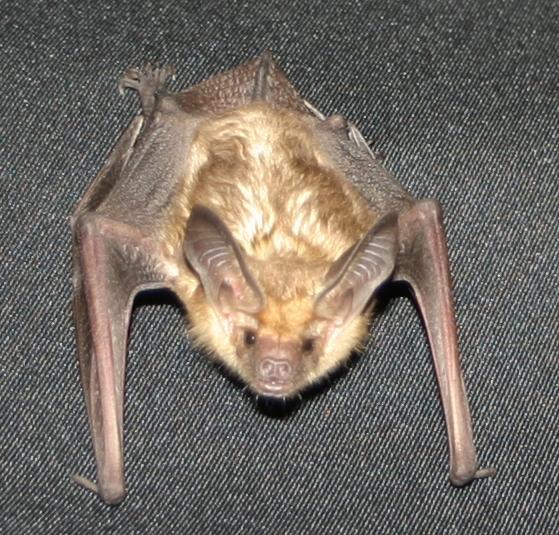California’s governor signed Senate Bill No. 732 (SB-732 Bats) in October, making the pallid bat (Antrozous pallidus) California’s official state bat.
SB-732, introduced by Senator Caroline Menjivar (D-San Fernando Valley), started with the efforts of ecologist Dr. Dave Johnston in 2017 and continued with Naomi D’Alessio, a 12-year-old advocate of bats and co-author of the bill.
The bill states that bats eat many pest species, including those that contribute to health risks, such as mosquitoes, wasps, and flies.
It also states that bats provide more than $1 billion worth of pest control to California agriculture and eat bark beetles and wood borers, reducing wildfire risk in California forests.
Dr. Johnston, a renowned wildlife ecologist and authority on bats with more than 40 years of experience, told The Epoch Times in an email: “Pallid bats are golden-colored, which matches the theme of California as the ‘Golden State.’ The Pacific Pallid bat is one of our larger bats in California, and they are found almost exclusively in California.”
He said when people see pallid bats up close for the first time, they say, “Wow … they’re really cool!”
He said pallid bats are very social animals and often prefer to hang out with specific “buddies.” Among other interesting facts about them, he said they find their prey not by echolocation but by passively listening to their prey’s low-frequency sounds. They eat insects and arthropods like beetles, spiders, and scorpions.
He’s hoping that SB-732 will bring greater awareness of the importance of bats for our ecosystems.
“I was relieved that we finally got our state bat of California. Many thanks to some new players like Naomi D’Alessio; her father, Dr. Matt D’Alessio; and the newly elected State Senator Caroline Menjivar to help take this effort over the finish line. There is so much more needed to make the public aware of all the great things bats do for us and the environment,” he said. “To be honest, it was a long haul.”
He said bats are an amazingly diverse group, and there are over 1,400 known species of bats worldwide.
“Bats are responsible for over a billion dollars of pest control management for California agriculture and about 3.7 billion dollars of pest control management for the United States,” he said.
A lactating female bat eats her weight or more in insects and other arthropods every night.
“That’s a lot of bugs!” he said.
He said this greater awareness of pallid bats will likely lead to more conservation of the species.
“As one of our state’s official symbols, the pallid bat should become more of a household name. Potentially millions of young children in California will learn more about bats through their state bat,” Mr. Johnston said.
Advocating for the bill during the Assembly Water, Parks, and Wildlife Committee hearing in June, Ms. D’Alessio said that pallid bats protect us from mosquito-borne diseases such as Zika and West Nile Virus.
“Pallid bats in different parts of the state speak to each other in different languages that we can actually tell apart,” she said.
She said that she had never seen a bat at her home, so she set up a microphone to record bat calls. On the very first night, she recorded 54 different bats from four different species, she said.
“Many of those exact bats have probably been eating mosquitoes in our yard for longer than I’ve been alive,” she said.
Mr. Johnston said the inspiration for establishing a state bat started in 2015 while conducting research on the Hawaiian hoary bat in Maui. That year, the hoary bat became the official state land mammal of Hawaii.
He then decided he would like to do the same for the pallid bat in California, so he petitioned for Resolution #17 52978, which passed the California State Senate on July 25, 2017 to recognize the importance of the pallid bat.
Mr. Johnston said his Ph.D. research showed that pallid bats specialize individually in their diets, meaning that in a single colony, no two bats had the same diet, and in some cases, there was no overlap in the diets of different bats. He also learned that in five different populations of pallid bats, only about 20 percent of the bats ate slugs.
He said he spent several years studying pallid bats in a laboratory and in the wild and learned that they have different personalities, just like other animals.

A pallid bat. (Courtesy of Dr. Dave Johnston)
Back in 1990, while serving as the executive director of the Youth Science Institute in San Jose, Mr. Johnston made an observation of pallid bats eating slugs. He said that this hadn’t been reported anywhere in the scientific literature or otherwise.
This led him to want to study bats further. He decided to contact Professor Brock Fenton, Emeritus Professor of Biology at the University of Western Ontario, who was an expert on bats. He said Mr. Fenton’s enthusiasm for bats rubbed off on him, so he entered a Ph.D. program at York University in Toronto with a 3-year scholarship to study bats under Mr. Fenton.
He said, “The rest is history.”
Mr. Johnston said there is a misconception about bats being blind.
“In fact, pallid bats can see quite well in very dim light,” he said.
He said another misconception about bats is that they carry rabies. He said that bats in the wild have the same percentage of rabies virus as other wild animals; that is, about one-half of one percent of a bat or mammal population is rabid.
Corky Quirk, founder of NorCal Bats, told the Epoch Times in an email that she was thrilled when SB-732 passed.
She said, “Bats often are overlooked or feared. They deserve attention as they are the major consumers of nocturnal agricultural pests. If you don’t like pesticides you must love bats.”
She said pallid bats are fairly unique for bats. They have huge ears that allow them to hear the movements of invertebrates on the ground.
She said the invertebrates they hunt for include grasshoppers, crickets, potato bugs, and large beetles as well as centipedes and scorpions.
She said they are immune to the venom of the scorpion and can produce a mild musk odor when scared.
According to the website Norcalbats, the pallid bat emerges from its roost about an hour after sunset to hunt, and then it heads back to digest its food. It will then hunt again before dawn. Pallid bats roost in small colonies of about 12 to 100 bats. They form nursery colonies and bear one or two pups each year, which nurse for 6 to 8 weeks.
She said there are many misconceptions about bats; they are not aggressive animals, and they don’t attack.
She added: “Most are healthy; any bat on the ground might be sick, but most aren’t. Rabies is passed through saliva. As long as one doesn’t handle the bat without protection, there is no reason to fear them.”
She said the pallid bat is found throughout the state in many habitats, including the coast, valley, mountains, grasslands, forests, and deserts.
“It is a large, beautiful, and charismatic bat,” she said.
Ms. Quirk said she wanted to study bats because she always loved the idea of flight and bats are mammals that can fly.
She added that she always had a soft spot for the underdog and loves sharing and teaching about these “amazing winged wonders.”
“State symbols bring the opportunity for education and attention. The pallid bat is an amazing bat that will now get attention,” she said.














